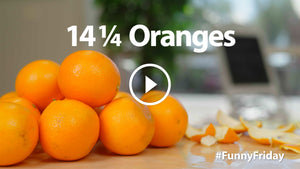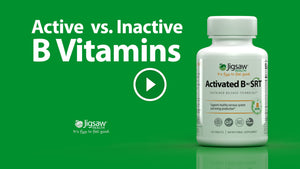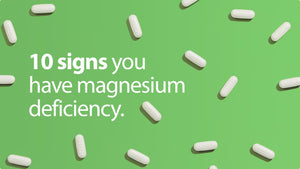"Fats for Fuel" & March Madness...
What do these have in common?
Thomas DeLauer breaks down the science behind how your body utilizes 'fats for fuel' and how March Madness makes understanding it a bit easier on the latest #ScienceSaturday
Make sure you are meeting the RDI 400mg of Magnesium per day with Jigsaw's MagSRT™ – America's #1 Time-Release Magnesium Supplement: MagSRT™
Click here to add 3 bottles of Jigsaw MagSRT™ to your cart and save $20.94 + $10 off.
Transcript by Rev.com
- What's going on Jigsaw land? It's time that you understand how fats really work in the body, when it comes down to beta oxidation. You know, when you go out for that nice hike or when you go out for a gentle jog, it's important that you know how your body is actually breaking down those fats that you ate the day before.
- So normally, when we're doing steady state cardio, our bodies are in a very efficient state, it's something called beta oxidation. It's a very efficient form of breaking down fats into energy. But efficiency isn't always what we want when we're trying to burn fat when you think about it. We don't want the most efficient way to create energy, we kind of want an inefficient way because that causes our bodies to have to adapt and thereby burn more energy, burn more fat, and burn more calories and ultimately lose weight and change your bodies.
- However, beta oxidation and the utilization of fats is a very phenomenal, very interesting thing and it does a lot for our body. So let's explain how it actually works so you have a solid understanding of how your body is literally using fats for fuel.
- So beta oxidation is simply where fatty acids are broken down into the mitochondria and ultimately broken down into Coenzyme A, which we can ultimately use for energy. Coenzyme A is the root of creating energy in general. But let me tell you about how the fatty acids are transported and how this process works and then it will all make a little bit more sense.
- So it starts with the fatty acid. A fatty acid molecule that comes form dietary fats or whatever the case may be. These fatty acids conjugate with Coenzyme A in what is called the Cytosol. The Cytosol is just the aqueous portion of a cell. If you visualize a cell, if you look at a diagram of a cell, you'll see that there is a liquidy portion in the center of the cell, that is the cytosol. So what happens is the fatty acid conjugates with Coenzyme A there and it creates something known as fatty acid Acyl-coenzyme A.
- This fatty acid Acyl-coenzyme A is then modified by something that a lot of us know as carnitine. Maybe you've taken an L carnitine supplement before and you've just believed that it helps you burn more fat. Well, now you'll probably understand how that actually works. The L carnitine reacts with the fatty acid that's already been conjugated and it carries it into the mitochondria. So that carnitine literally is a transporter to get it into the inner membrane of the mitochondria where we create energy. The mitochondria is the power house of a cell where we create energy. So it goes from being inside a cell in the cytosol, processed through the membrane in the mitochondria, to where it can start being utilized for energy, but now, we have to understand how that process actually works.
- So, I want you to visualize the fatty acid breakdown like a March Madness bracket or like a sports betting bracket or something like that. So, you end up having this long chain fatty acid, this long chain fatty acid that's inside your mitochondria and it starts breaking down. It breaks down through dehydrogenation so it means that hydrogen molecules are removed. These hydrogen molecules are removed and water is added in. Then, this cleaving process occurs.
- So, you've got this fatty acid that's been modified a little bit and then a portion of it gets cleaved off. The end of the fatty acid gets cleaved off making a shorter fatty acid. That fatty acid goes to the top of the cycle and starts to process again where hydrogens are removed, water is added, and a portion cleaved off becomes even smaller and then it goes through the process again until there's nothing left but acetyl-coenzyme A. So, when I reference it like a sports bracket, it literally is like that. It starts like a total wide funnel at the top, breaks down more, breaks down more, breaks down more, until you're left with nothing but acetyl-coenzyme A which is pure energy. And this process is very unique and it obviously involves oxidation where it requires oxygen, it requires dehydrogenates to remove hydrogen. Very complex process yet it yields a lot of energy.
- So, now I'm gonna explain how this works when it comes down to steady state cardio. So, so many people will bag on steady state cardio because they think they're gonna burn a lot of muscle and everything and like that. Well, the thing is, steady state cardio predominantly uses fats as a source of fuel because as you can tell, when I'm explaining this process, it takes a long time to create energy. It's slow, it breaks down fatty acids in a slow way but in ends up creating over 100 ATP every time it goes through this process whereas when we're utilizing carbs as a source of fuel, we're only creating 36 ATP. Now, in case you don't know, ATP is literally just another word for energy, it's Adenosine triphosphate, it's basically the root of energy in your body. It is energy.
- So we create a hundred units of energy through beta oxidation from fat and we create 36 units of energy from ATP through glucose metabolism. So you can start doing the math, you can see, yes, you could potentially burn more fat because you're gonna have to work harder to create more ATP with carbohydrates. With fat as a source of fuel, your body runs efficiently. So, that's the caveat. With low intensity cardio, you have a direct line to utilizing fats. You're going to utilize fats but your body is gonna utilize them a little bit slower.
- With anaerobic activity where you use carbs, your body is gonna have to work harder, it's inefficient, it hurts more but you do burn more calories, not necessarily more fat, but more calories but you have to work harder, you have to work three times as hard. So, I hope that that makes some sense, but when you look at the big picture, that is how low intensity cardio helps you burn fat. It's not a bad thing, only if you go to the extreme. I'm always a fan of both high intensity and low intensity but it all depends on the situation.
- As always Jigsaw land, if you're trying to make the most out of your body and become efficient in all the processes, you wanna make sure that you check out Magnesium SRT by Jigsaw so that you can help support the 300 enzymatic functions that occur in the body that require magnesium. So click on the link and you can learn a bit more about how magnesium can help your day. See you soon.























